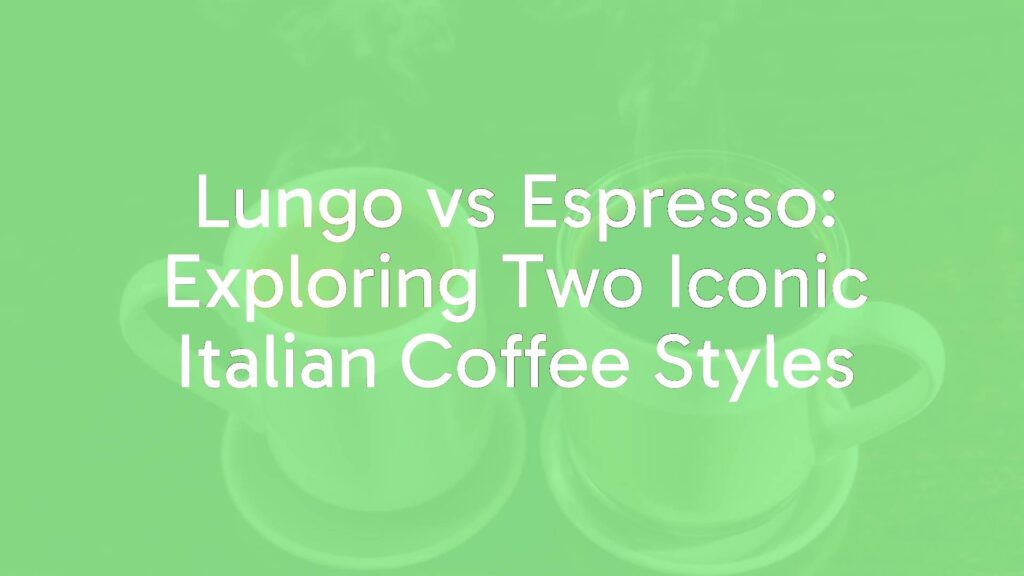Lungo vs Espresso: Exploring Two Iconic Italian Coffee Styles
Introduction
The world of Italian coffee offers a remarkable variety of drinks, each with its own preparation style and sensory experience. Among these, the lungo and espresso stand out as two closely related yet distinct coffee drinks. Though they both originate from the same espresso tradition, their differences in brewing and characteristics have made each beverage beloved in its own right. This article delves into the key similarities and unique features that set lungo and espresso apart.
Historical Roots and Evolution
Espresso has long been the cornerstone of Italian coffee culture, developed in the early 20th century as a quick, strong coffee extract prepared under high pressure. The term “espresso” itself refers to both the method and the intent: to express the best from coffee beans in a short time.
The lungo, which means “long” in Italian, evolved as a variation of espresso for those seeking a milder, more diluted cup. The method naturally gained popularity among coffee drinkers who enjoyed a less intense yet still flavorful coffee experience. While espresso is the staple in Italian cafes, lungo holds a steady presence, especially among those who appreciate a larger, lighter beverage.
Key Ingredients and Proportions
Both drinks start with the foundational ingredient: finely ground coffee beans of espresso roast. The biggest difference lies in the water-to-coffee ratio:
- Espresso: Typically brewed with about 7–9 grams of ground coffee, yielding 25–30ml of concentrated coffee.
- Lungo: Uses the same amount of ground coffee but employs about double the water, resulting in a 60–90ml drink.
Preparation Methods and Techniques
Both drinks are prepared using an espresso machine, but the extraction times and water volumes differ significantly:
- Espresso: Extracted in around 25–30 seconds, using high pressure and minimal water. The result is an intense, aromatic shot with a creamy crema on top.
- Lungo: Extracted for a longer period, often between 45–60 seconds, allowing more water to flow through the grounds. The extended brewing time imparts a different flavor profile and a lighter body.
Flavor, Texture, and Appearance
The contrasting preparation methods lead to distinctive sensory characteristics:
- Espresso: Known for its bold, concentrated flavor and velvety texture, boasting a thick crema and lingering aftertaste.
- Lungo: Presents a lighter body, with a more diluted flavor and increased bitterness. Although it still offers a crema, it is often thinner and lighter in color compared to an espresso.
Serving Traditions and Presentation
Espresso is customarily served in small, thick-walled demitasse cups to preserve heat and intensity. Lungos, being larger in volume, are typically offered in slightly bigger cups. Both drinks are enjoyed without milk in their classic forms, though personal preferences vary.
Common Misconceptions and Frequently Asked Questions
- Does lungo simply mean a diluted espresso? While lungo uses more water, it is brewed differently—by prolonging extraction rather than just adding hot water after brewing (which would produce an ‘Americano’).
- Is lungo weaker than espresso? Lungo is less concentrated and often perceived as milder, but the longer extraction may extract more bitter compounds, making its flavor distinctively more bitter, not just weaker.
- Do both drinks have the same caffeine content? A lungo can have slightly more caffeine than an espresso due to the extended extraction, though the difference is not dramatic and varies based on preparation specifics.
Conclusion
Though the lungo and espresso share a common heritage and rely on similar ingredients and equipment, each offers a unique tasting experience shaped by their distinct brewing techniques. Espresso delivers a compact punch of flavor and body, perfect for those who appreciate intensity. Lungo provides a longer, gentler journey through the spectrum of coffee flavors, appealing to those who prefer a larger cup without compromising the essence of the bean. Both remain enduring staples of Italian coffee culture, each suited to different moments and tastes.

